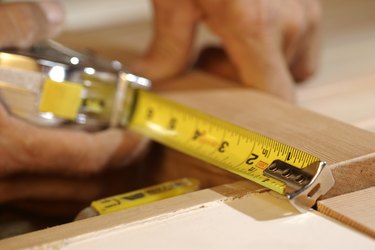Things You'll Need
Measuring tape
Level
Chalk line
Plumb bob
String
One-by-six wood planks
Nails
Hammer
Stakes
Saw
Masonry saw blade
3/8-inch rebar
Medium bristle broom
Concrete
Concrete mixer
Gloves
Rubber boots
Edging trowel
Wood float
Steel trowel
Two-by-four wood screed

Curb ramps make it possible to transition from a sidewalk area to a lower level that could be a street or a parking lot. While it may seem simple enough to build a ramp that slopes to meet the lower level surface, there are requirements for building a curb ramp. One of biggest requirements it needs to meet is the Americans with Disabilities Act or ADA. ADA requires all ramps, even curb ramps, to meet certain slope requirements so that people who are disabled can use them safely.
Measuring
Step 1
Measure the area where the curb ramp will be located. The location of the curb ramp will dictate the layout and size of the curb ramp. They can be on the corner or in the middle of a sidewalk. There will always need to be 48 inches of walkway around the curb ramp no matter what the layout of the curb ramp.
Video of the Day
Step 2
Mark the location of the main ramp area for the curb ramp using the stakes and the string. The main ramp area must have a maximum 1:12 slope which is approximately 8.33 percent and it must be 48 inches wide.
Step 3
Mark the location of the side ramps using the stakes and string. They can have a steeper slope of 10 percent maximum from the sidewalk level to the lower level.
Step 4
Once the area is marked, you can begin to excavate or demolish whatever is in the way of the new curb ramp.
Step 5
Saw cut the edge where the ramp will meet the existing sidewalk. You will want to use the masonry blade with your saw so you can get a clean, straight edge.
Form Work
Step 1
Clean away any dust left from where you cut the concrete with the masonry saw blade. The edge where the new curb ramp will meet the existing concrete sidewalk will serve as the form work for the concrete curb ramp at those areas, which is why you will want it free from as much dust as possible.
Step 2
Place the one-by-six wood planks at the bottom open edge of the ramp where it meets the lower level.
Step 3
Cut the wood planks to match the 10 percent slope of the side ramp and the length of the side ramps so you can use it as a guide when you are leveling out the concrete.
Step 4
Hammer the stakes in the ground to hold the one-by-six wood planks in place. Make sure you use enough stakes to hold the planks or the concrete will blow it out when it is being poured.
Step 5
Place rebar inside the area where the concrete will be poured. You will want to locate them every 6 inches or so and create a grid. Tie the rebar together so they act as one piece of steel. This will give the concrete strength in tension and help to prevent it from cracking.
Step 6
Make sure the rebar is lifted off the ground so it will be in the center of the concrete when it is poured. You can place them on top of rocks or specially made "chairs," or you can simply lift the rebar up as the concrete is being poured.
Pouring the Concrete
Step 1
Mix enough concrete to complete the entire job during one pour. You do not want to have to come back after the concrete has cured to pour more concrete, because this will create a cold joint and weaken the concrete. The concrete should form a ball that can be held together without any water oozing out or being too crumbly.
Step 2
Pour the concrete starting at the top of the concrete curb ramp. Gradually move across the area where the concrete needs to be poured.
Step 3
Screed the concrete after a few feet of concrete has been poured. Using a sawing motion, move the wood back and forth on the concrete. This will help to distribute the concrete.
Step 4
Once the area has been completely filled with enough concrete, you need to vibrate the concrete with the vibrating machine. This will help to distribute the concrete area all through the rebar and get rid of the small pockets of air that were created during the pour.
Finish the Concrete
Step 1
Once you have vibrated all the air out, you are ready to trowel the concrete with the wood float, first using sweeping arcs. This will help level the concrete. The concrete needs to be very firm at this point to do the finishing.
Step 2
Use the edge trowel to finish the edges. This will help round the corners of the concrete out so they will not chip or crack later.
Step 3
Use the wood planks as a guide to follow and meet the 10 percent slope on the sides.
Step 4
Use a damp, medium-bristle broom to create a texture across the ramp by pulling it across the surface. This will produce a non-skid finish to the surface to prevent people from slipping when the concrete is wet. After a day, you can remove the form work.
Step 5
Allow the concrete to dry for approximately 30 days before using it. You can cover it with plastic or with burlap that is kept moist. You do not want the concrete to dry out too quickly or it will crack.
Tip
Order enough concrete to finish the job.
Wear rubber boots and gloves when pouring and finishing the concrete.
Mix the concrete in small workable batches, because it can harden quickly.
Video of the Day